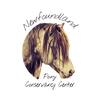If you ask someone about the Newfoundland Pony and what makes it so different, chances are you're going to hear them called a "landrace breed". Most people have either never heard of it, or think of animals such as pigs and cows. So, what makes a "landrace", and why does it matter?
Well, a landrace is a "locally adapted, traditional variety of a species of animal or plant that has developed over time, through adaptation to its natural and cultural environment of agriculture and pastoralism, and due to isolation from other populations of the species." Whew. That's a lot. But what does it mean? It means that a landrace is any species that has evolved to suit its environment through the environment. An Native Island Pony breed, Newfoundland Ponies weren't kept penned or corralled when on the island, but were instead allowed to wander, graze and find shelter as needed when they weren't being worked. There weren't fencing laws on Newfoundland island for years. When the fishermen would leave, they would turn the ponies loose and let them fend for themselves (which they were quite good at) until people returned from their boats. Stories are told about how they could tell which house to go to for more food, which one was their owners', and would come to greet fishing boats as they came in from the sea.
For more on how landrace breeds differ from standardized breeds, see here.
Why does it matter? This native island pony breed is the result of natural interbreeding (not inbreeding) which means they evolved to suit their rugged island environment without human intervention. The horses and ponies that came over with the settlers were left to their own devices to roam and breed, eventually creating their own unique and identifiable breed without human input. All of their characteristics are for survival on an island that routinely has icebergs floating by in the summer. This also means that any characteristic or genetic trait that didn't aid the Pony in its survival was eliminated one way or another - survival of the fittest.
Well, a landrace is a "locally adapted, traditional variety of a species of animal or plant that has developed over time, through adaptation to its natural and cultural environment of agriculture and pastoralism, and due to isolation from other populations of the species." Whew. That's a lot. But what does it mean? It means that a landrace is any species that has evolved to suit its environment through the environment. An Native Island Pony breed, Newfoundland Ponies weren't kept penned or corralled when on the island, but were instead allowed to wander, graze and find shelter as needed when they weren't being worked. There weren't fencing laws on Newfoundland island for years. When the fishermen would leave, they would turn the ponies loose and let them fend for themselves (which they were quite good at) until people returned from their boats. Stories are told about how they could tell which house to go to for more food, which one was their owners', and would come to greet fishing boats as they came in from the sea.
For more on how landrace breeds differ from standardized breeds, see here.
Why does it matter? This native island pony breed is the result of natural interbreeding (not inbreeding) which means they evolved to suit their rugged island environment without human intervention. The horses and ponies that came over with the settlers were left to their own devices to roam and breed, eventually creating their own unique and identifiable breed without human input. All of their characteristics are for survival on an island that routinely has icebergs floating by in the summer. This also means that any characteristic or genetic trait that didn't aid the Pony in its survival was eliminated one way or another - survival of the fittest.
